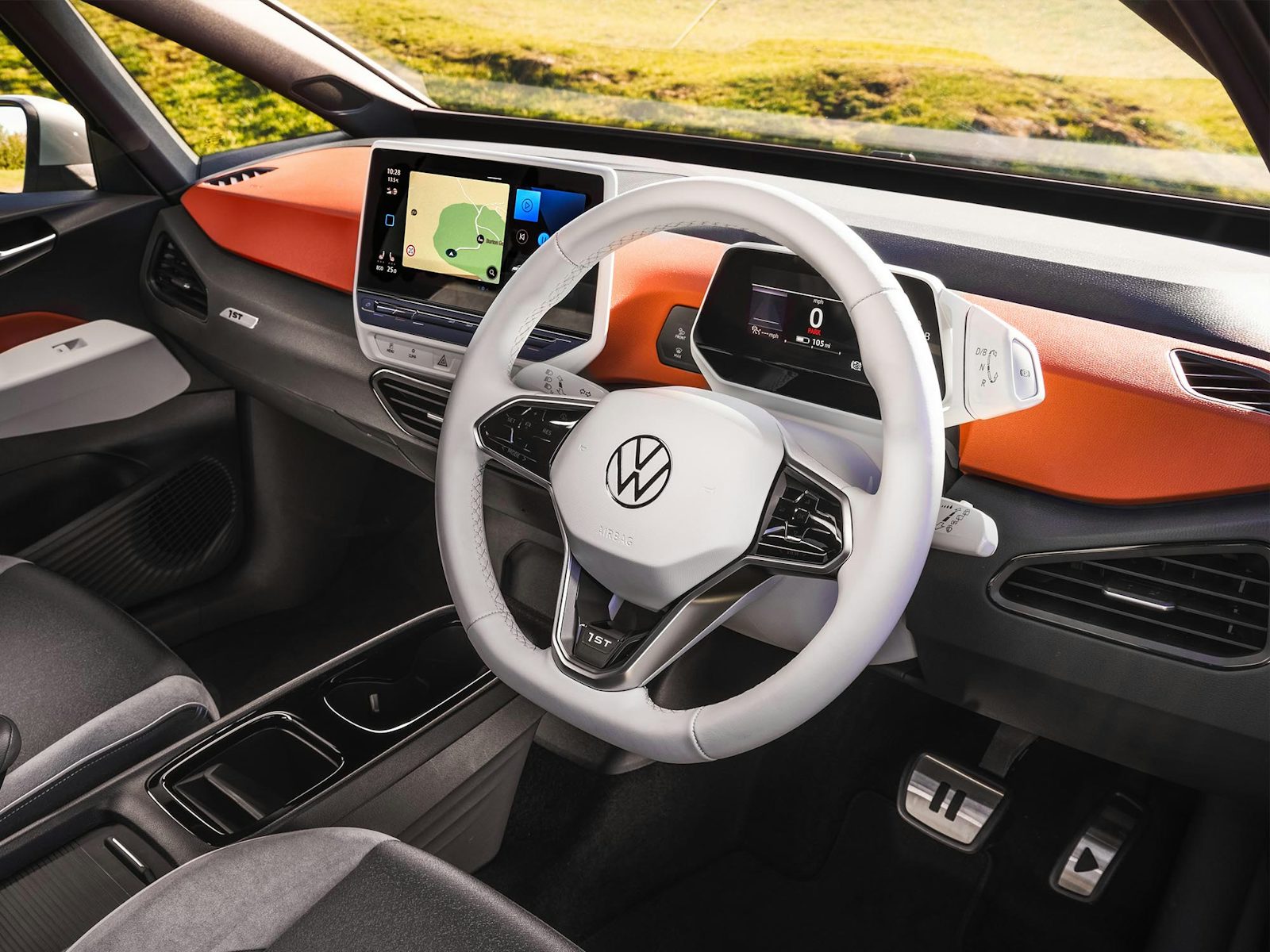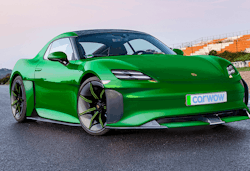How to drive an electric car
March 27, 2023 by carwow staff

EVs cars bring many advantages over petrol and diesel cars, but they also need a slightly different approach to driving; we explain all
Electric cars are rapidly growing in popularity, and by 2035 any new car sold in the UK will have to be electric or electrified. The good news is that driving an EV is simplicity itself.
As with any new technology, there are a few points to consider to get the best out of your EV experience. This guide will go into the finer details of EV driving, helping you make the transition as smoothly as possible.
Electric car driving: the basics
Have you ever driven a golf cart or done a few laps in a go-kart? If so, you’ve already got the basics of EV driving under your belt.
Modern EVs are extremely simple to operate: slip into the driver’s seat, turn the car on (typically with a button, and your foot on the brake, though some detect when you climb aboard and turn on automatically) and the dashboard will light up and a confirmation chime sound.

All electric cars are automatics, albeit with just one gear. You select drive (D) or reverse (R) as you would with a conventional automatic gearbox, typically either via steering-column mounted stalk, buttons on the centre console, a rotary controller or a conventional lever (though some Teslas use the touchscreen for gear selection).
Most EVs have an enelctronic handbrake that should automatically release as soon as you start moving. EVs also tend to have a ‘creep’ function that can be toggled on or off; when it’s active, the car will move forward very slowly if you take your foot off the brake and don’t apply the accelerator – just as it would if it were a petrol/diesel car with an automatic gearbox.
Because EVs are so quiet, the law mandates they emit an artificial sound until they reach 12.5mph (at which point tyre and wind noise make their presence obvious) to warn pedestrians and cyclists of their presence.
EVs also have regenerative braking systems which convert the vehicle’s kinetic energy as it slows, into electrical energy that is put back into the battery. This means that when you let off the accelerator pedal the car starts to decelerate immediately. The strength of regenerative systems can usually be adjusted so they either slow the car very little when the accelerator pedal is released, or so much that you need hardly use the brake pedal at all – something that is known as ‘one-pedal driving’. Adjustment is often done via paddles on either side of the steering wheel, or via the touchscreen.
An electric car will weigh more than an equivalently sized petrol or diesel vehicle due to its hefty battery pack. These are usually placed beneath the floor which gives them a planted feel on the road, although not all EVs offer particularly sporty handling. Ride comfort is generally good among EVs, although some less refined models can feel hard over bumps and rough road surfaces.
When you come to the end of your trip, you put the transmission into park, depress the stop/start button and that’s it. The majority of EVs also come with an app which allows you to heat or cool the cabin before departure, check on the battery charge and operate various interior features remotely. Pre-conditioning your car by getting the interior and the battery pack to the right temperature while it’s still plugged in can actually increase your range.

How does driving an electric car differ from driving a petrol or diesel car?
While driving an electric car is really simple, the driving experience itself is quite different to petrol and diesel cars.
Acceleration
EVs do not need to warm up or be in the right gear to provide their best performance. Electric motors produce their maximum torque (the thing that presses you back into your seats when you accelerate) all of the time. That means that even the smallest EVs will leap away from the traffic lights faster than just about any conventional car.
This intense initial acceleration does taper off as the speeds rise, most EVs are limited to below 100mph, but most are very quick and responsive up to the UK’s legal speed limits and during overtaking. Some performance EVs like the Porsche Taycan, offer a two-speed transmission, this allows for stronger acceleration at Autobahn speeds, where a regular EV would usually be moving over for a petrol-powered car.
Braking
Regenerative braking systems are another big feature of EVs: these harness kinetic energy, which would otherwise be wasted, of the vehicle as it is slowing down, converting it into electrical energy to top up the battery pack. This means that the car will start to slow down as soon as you lift your foot off the accelerator pedal.
It may seem odd at first, but it quickly becomes second nature to glide to a stop without touching the brake pedal. Most cars offer a range of settings for the regenerative braking system, allowing one pedal driving. Nissan’s e-Pedal system and Hyundai’s i-pedal take it one step further and incorporate braking and acceleration in to one pedal, making driving an EV even simpler.
You can usually choose different settings for strength of the regenerative braking system; this is sometimes done via the touchscreen, sometimes by paddles to either side of the steering wheel, and sometimes by choosing ‘B’ mode on the gear selector.
Sound
Petrols and diesels make all sorts of sounds from under their bonnets and out their exhaust pipes. These range from the mildly annoying to captivating mechanical symphonies and depend on all sorts of technical factors.

EVs make a low whuuuuuuuum sound, some add artificial aural accompaniments to this near-silent progress. In the case of high-end luxury EVs, like the BMW iX, this can be by renowned composer Hans Zimmer, in less aspirational models it will be a series of beeps and boops thrown in during development. EVs also emit an artificial sound outside the cabin to alert other road users of their presence.
Range
Petrol and especially diesel cars still have an edge when it comes to the total range between refills as well as the time it takes to refill with fuel.
Petrol and diesel cars are only limited by the size of their fuel tanks on how far they can go without refuelling (usually between 350 and 600 miles). Some manufacturers offer larger fuel tanks as an option, and if you’re heading off road, a few extra jerrycans of fuel will get you the extra mile or miles. When you don’t need the range, you can leave the tank partially empty which helps keep overall weight down.
The longest-range electric cars are currently around the 400-mile mark, this figure is slowly increasing with new battery technology and more efficient designs. The downside is that battery packs are heavy, and they weigh the same regardless of whether they’re full or completely discharged. Recharging is slower than filling a petrol tank, but rapid charging technology is quickly closing that gap and the charging infrastructure is constantly improving, too.
Our comprehensive guide to EV charging has all the information you could need.
How to increase an electric car’s range
Range is one of the biggest talking points around electric cars because long (relative to filling a fuel tank) recharge times, coupled with a greater sensitivity to outside influences, means they need greater planning and consideration compared to petrol and diesel cars.
Things that affect an electric car’s range include:
- Ambient temperature: EV batteries don’t like it when it’s very cold or very hot outside, with cold weather having a notably big impact on range.
- Speed: all cars use more energy at high speed – it’s the laws of physics – but EVs tend to suffer far more from high speed than petrol and diesel ones.
- Auxiliary systems: using the air-conditioning, cabin heating and other creature comforts draw energy from the batteries to run, reducing range.
There’s not a lot you can do about the weather outside, but if your EV has a cabin preconditioning feature that allows you to warm its interior using power from the mains when it’s plugged in and charging, make use of this feature and you’ll save battery energy, increasing range in the process.
Also note that energy use increases significantly with speed, so cruising at 63mph rather than 68mph could see you go a fair bit further on a charge.
Similarly, while it’s neither recommended nor pleasant to freeze or bake in a car, turning the heating/air-con down, or off when you don’t need it, will increase your range.
Many EVs have sophisticated range management systems that will display the projected distance you can cover when you have certain systems on; for example, the infotainment system might suggest turning the heated seats off to gain a few miles extra range.

What are the best electric cars to buy?
From sensibly priced hatchbacks to supercar humbling saloons, the range of EVs on offer is constantly growing, here are five of the best ones out there.
1. MG 4

Impressively good value, fun to drive, handsome and with a decent range, the MG 4 is arguably one of the most important and in-demand EVs to have emerged in the last couple of years.
2. Tesla Model 3

The Tesla Model 3 offers plenty of advanced tech and performance to rival far pricier petrol sports cars. The interior is very futuristic, with a large touchscreen controlling most major functions and the Long Range Model 3 is capable of doing 374 miles on a single charge.
3. Kia EV6

The Kia EV6 is a superb family-friendly EV, with impressive range (300-328 miles), great tech and great handling. The quickest model currently is the 321bhp all-wheel-drive version, capable of hitting 60mph in 5.1-seconds. If you want even more, a 577bhp GT version is even quicker.
4. BMW iX

Sure, the looks are divisive (though they’ve grown on us), but the BMW iX has one of the best interiors around, plus is fantastic to drive and can officially cover up to 382 miles on a single charge. It’s not cheap, but it certainly delivers the EV goods.
5. Porsche Taycan

The Taycan is Porsche’s first pure EV, and it’s a rather good one. It handles as well as a traditional sports car, with a sledgehammer dose of electric acceleration. The 751bhp Turbo S is capable of a 0-60mph time of under 2.8-seconds and has a mixed driving range of 291-miles. Perfection doesn’t come cheap, though, so be sensible with the options list.
Car Change? Carwow!
Looking for a new set of wheels? With Carwow you can sell your car quickly and for a fair price – as well as find great offers on your next one. Whether you’re looking to buy a car brand new, are after something used or you want to explore car leasing options, Carwow is your one stop shop for new car deals.















